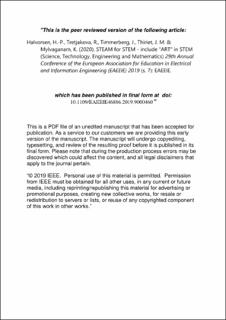| dc.contributor.author | Halvorsen, Hans-Petter | |
| dc.contributor.author | Tretjakova, Rasma | |
| dc.contributor.author | Timmerberg, Josef | |
| dc.contributor.author | THIRIET, Jean | |
| dc.contributor.author | Mylvaganam, Kanagasabapath | |
| dc.date.accessioned | 2020-02-25T12:41:47Z | |
| dc.date.available | 2020-02-25T12:41:47Z | |
| dc.date.created | 2020-01-31T13:15:51Z | |
| dc.date.issued | 2019 | |
| dc.identifier.citation | 29th Annual Conference of the European Association for Education in Electrical and Information Engineering (EAEEIE) 2019. | en_US |
| dc.identifier.isbn | 978-1-5386-7712-4 | |
| dc.identifier.uri | https://hdl.handle.net/11250/2643647 | |
| dc.description | Personal use of this material is permitted. Permission from IEEE must be obtained for all other uses, in any current or future media, including reprinting/republishing this material for advertising or promotional purposes, creating new collective works, for resale or redistribution to servers or lists, or reuse of any copyrighted component of this work in other works. | en_US |
| dc.description.abstract | After a fairly recent study discussed in IEEE Spectrum, with the catchy title, “want-girls-attracted-to-tech-put-a-for-art-in-stem”, on the strategies of attracting more female students to opt for studies in STEM (Science, Technology, Engineering and Mathematics), the acronym STEM has been modified to STEAM (Science, Technology, Engineering, Art and Mathematics), by adding “art” as a topic in the curricula. In a recent study, the authors of this paper noted that there has been and there is still an on-going discussion on the low percentage of females in STEM (Science, Technology, Engineering and Mathematics) related studies. Some initiatives of engineers in the USA and Canada and current discussions in the IEEE community support the idea of adding an A (for Arts) in STEM leading to STEAM. With the element of gamification in many subjects and associated elements of Art in many disciplines, this strategy may help to improve the number of female students, as confirmed by a study performed in 2016. Topics with the hue of art are found in many STEM subjects and the staff responsible for courses can tune the content to accommodate these in already existing programs by putting more emphasis on “Art”. This paper addresses possibilities of adding elements of “Art” in existing courses with Biggs' Teaching and Learning, Intended Learning Outcomes and Assessment with gender balance in focus. The example of the Shad, Canada's successful STEAM and Entrepreneurship Live-in program for high-school (i.e. pre-university) students are cited. With respect to Biggs' model and using problem based learning (PBL), we point out, how the curricula in our universities in electrical engineering, IT and system engineering have many similarities with the pedagogical goals of the Shad program. This paper presents possibilities of incorporating elements of “art” related topics in disciplines under focus in the EAEEIE-community. Experiences from some courses in our universities are also provided with some pertinent conclusions for STEAM studies with enhanced gender balance on national, regional and international levels. | en_US |
| dc.language.iso | eng | en_US |
| dc.relation.ispartof | 29th Annual Conference of the European Association for Education in Electrical and Information Engineering (EAEEIE) 2019 | |
| dc.title | STEAM FOR STEM - INCLUDE "ART" in STEM (Science, Technology, Engineering and Mathematics) | en_US |
| dc.type | Chapter | en_US |
| dc.description.version | acceptedVersion | en_US |
| dc.rights.holder | © 2019 IEEE. | en_US |
| dc.source.pagenumber | 7 | en_US |
| dc.identifier.doi | 10.1109/EAEEIE46886.2019.9000460 | |
| dc.identifier.cristin | 1788167 | |
| cristin.unitcode | 222,58,2,0 | |
| cristin.unitname | Institutt for elektro, IT og kybernetikk | |
| cristin.ispublished | false | |
| cristin.fulltext | postprint | |
